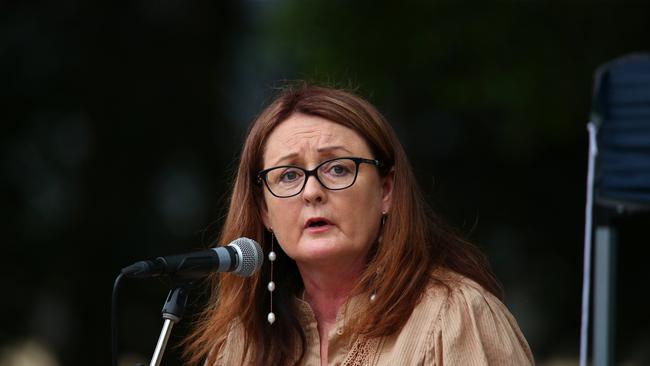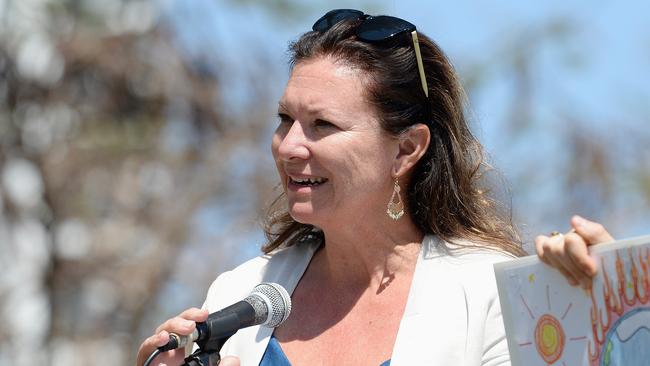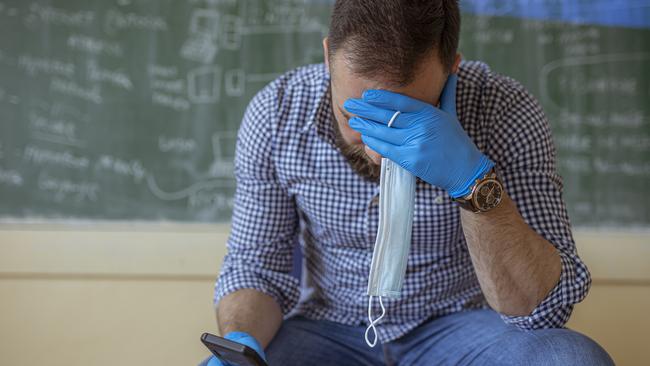Gold Coast teachers are abandoning the classroom and its contributing to a statewide crisis
Gold Coast teachers are in short supply, but the real crisis is the number of qualified and registered educators who have fled the classroom.
Education
Don't miss out on the headlines from Education. Followed categories will be added to My News.
Collapsed classrooms, a ‘flying squad’ of emergency teachers and critical vacancies in schools … there is no doubt we are in midst of an education crisis.
But the issue is not a teacher shortage. Not technically, anyway.
In fact, it’s worse than that.
The true problem is that there are not enough teachers teaching.
There are hundreds and hundreds of trained, qualified and experienced teachers in our city right now who would not dare darken the door of a classroom.

Immense workloads, increased paperwork, demanding parents, a spike in behavioural problems for a wage that, for many, is just not worth it.
And so our teachers walk away.
A study released by the federal government’s Australian Institute for Teaching and School Leadership in December found a quarter of teachers said they intended to leave the profession before they retired, and more than half of those planned to leave within the next decade.
It found one in three teachers aged under 30 intended to leave over the coming 10 years.
A new “flying squad” of metropolitan teachers has been created to fill regional classrooms with the Teacher Rapid Response Team being piloted this year to address the increased number of critical vacancies in Queensland schools.
The Queensland Teachers’ Union says critical teacher shortages have led some schools to group multiple classrooms together, called ‘collapsed classrooms’, with students supervised rather than receiving face-to-face teaching of subjects.
“Schools are having to cover the gaps as best they can. I have been advised that some classes are being placed together in multi-teaching spaces and supervised by heads of departments, deputy principals and principals, because they couldn’t get the necessary supply teachers,” says QTU general secretary Kate Ruttiman.

“I’m also aware of deputies having to take on a teaching load for one day a week, and heads of department – who are meant to have a maximum teaching load of 40 per cent – reducing their release time to ensure that students have a teacher to work with them.”
While the Queensland Government ensures us there are plenty of future teachers in the pipeline, with Education Minister Grace Grace saying the state is ‘on track’ to meet its commitment to employ 6190 new teachers and 1139 new teacher aides over the next four years, that is of little real solace.
After all, when the problem is that your professional workforce would rather walk away than continue their career, how will training more teachers ever be a solution?
We can absolutely make more teachers … but can we make them teach?
We need to change the environment, the conditions and the treatment of our teachers. We need to find a way to woo our educators back to the blackboards and smart screens.
An increase in pay could certainly form part of this package of pursual, but that’s not the crux of the problem.
Just ask Luke Eisenhuth. The former teacher and education consultant with Schoolhouse, a targeted recruitment service for schools and educators, says the agency is actively trying to attract teachers back to their profession.

“The question is whether there really is an actual teacher shortage … because there are a lot of registered and qualified teachers out there. But how do we attract them back in?” Mr Eisenhuth says.
“So many have opted out of the system and many who stay no longer want to work full-time because the pressure is too much. They would much rather do casual and relied work where they can earn more with less responsibility and stress. That’s not how the system should work.
“Unfortunately, I know from my own personal experiences I’ve had in schools, so often it’s the good teachers who just quietly slip away … they receive no recognition, no support, so why stay?
“There’s also a real wellbeing crisis. With our agency we’re trying to target that, to work with teachers and schools to see how they can be better supported so they are not crushed under the pressure.”
But one agency can only do so much.
If we really want to address our ‘teacher shortage’, we have to change the professional environment of our schools. We have to find a way to remove the excess paperwork, debilitating stress and unnecessary admin and let our teachers teach.
It’s the only way to ensure that the classroom door is no longer a revolving door.
Teacher crisis forces schools to take drastic action
Principals have been forced back into the classroom, learning disrupted and play areas closed during lunch breaks as a result of chronic teacher shortages at Gold Coast schools.
Management at a number of schools have had difficulty finding relief teachers to replace staff who have taken ill amid an upsurge in flu infections.

In a message to parents this week, the principal of one Gold Coast state school said it had a “large number” of staff members who were sick and was “struggling to find replacement staff each morning”.
“Across the country, there are significant staffing shortages in all employment sectors and we are no different,” the principal wrote.
“We are struggling each day to find replacement teachers for those who are away sick. Sometimes if a teacher is away and we cannot secure a replacement for them, the class will be split and shared among the other classes on that year level.”
Concerns over teachers salaries and working conditions have been historically raised by union officials as key reasons for the industry’s staffing drain in the Sunshine State.
But now the problem has become exacerbated by record cases of influenza in Queensland, with numbers recorded across May and June far in excess of what was seen in the previous five years.

Queensland Teachers Union (QTU) Gold Coast organiser Jodie McFadden said the situation was not sustainable.
“The QTU has been advocating for action to address teacher shortages for years,” Ms McFadden said.
“The reality is certainly biting now and it is not just as a result of Covid and flu season.
Rural regions across Queensland have struggled to recruit and retain teachers for many years, now the Gold Coast is also experiencing that.
“I am aware of increasing instances of principals and deputies teaching classes because they cannot fill short term vacancies on the Gold Coast,” Ms McFadden said.
The problem has affected both state and private schools at all levels.
More than a dozen private and Catholic schools have active vacancies, including elite St Hilda’s school, which this week posted an advertisement seeking casual relief teachers for its Pre-Prep, Junior and Secondary campuses.
State schools across the Gold Coast also have positions multiple positions open from principal to teacher’s aide level.
Queensland Teachers Union (QTU) Vice President Leah Olsson told the Bulletin the teacher shortage across the state had reached “crisis point”.

Ms Olsson said schools had been requiring senior staff in non-teaching roles to take on subjects and classes, doubling classes or redistributing students across year levels. She said part of the problem was that salaries in public schools were “falling behind” those in other states, making it harder for schools to retain key staff.
“It is important that we not only attract teachers to our profession but that we keep teachers and school leaders within the Queensland state school system,” Ms Olsson said.
“One of the ways that this can be done is to make sure our salaries, which are currently falling behind those in other states, are higher if not commensurate than our interstate counterparts.
“Ultimately, we should be supporting and respecting the profession and valuing the important role they play in the lives of students and our communities.
“ … they deserve recognition for this – and they deserve more than praise.”
WHAT DID THE EDUCATION MINISTER HAVE TO SAY?
Education Minister Grace Grace told the Bulletin: “The combined impact of Covid and flu has created challenges for schools and education systems across the country, including in Queensland.
“We are always working with schools to address teacher vacancies,” she said.
“In terms of covering short term vacancies caused by illness, my department maintains a strong relief teacher supply through the extended TRACER booking service.
“In terms of filling longer term vacancies, the Palaszczuk government is proud of our investment in teaching an schools in Queensland, and of our 96 per cent retention rate among teachers.

“Our government offers incentives including relocation assistance, subsidised housing and one of the highest graduate starting salaries in the country.
“We made a commitment at the last election to employ 6,190 new teachers and 1,139 new teacher aides over the next four years, and we are on track to meet that commitment. We have also employed more than 6,000 FTE new teachers since 2016, as well as more than 1,500 FTE new teacher aides.
“Our Turn to Teaching election commitment will employ and support 300 aspiring teachers to undertake a teaching qualification over the next three years. There are currently 55 participants studying in their first year of the program.
“Queensland teachers have fair and reasonable wages and conditions, and our teachers’ salaries are competitive with those across the country.”
*additional reporting by Brianna Morris-Grant




